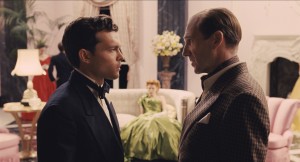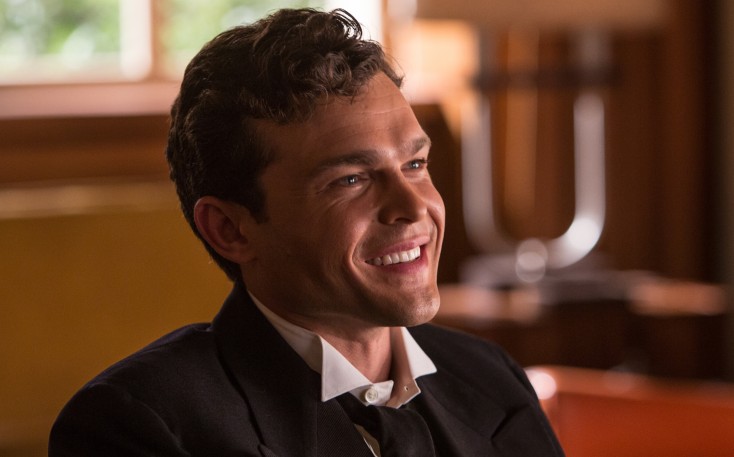
(L to R) Rising star Hobie Doyle (ALDEN EHRENREICH) speaks with director Laurence Laurentz (RALPH FIENNES) in HAIL, CAESAR!. ©Universal Studios.
By ANGELA DAWSON
Front Row Features
HOLLYWOOD—In Joel and Ethan Coen’s “Hail, Caesar!” he gets third billing, after Josh Brolin and George Clooney, but odds are audiences may not be familiar with the actor Alden Ehrenreich. That could change after his starring turn as an acting-challenged singing cowboy named Hobie Doyle who gets mixed up in a kidnapping plot in the Golden Age of Hollywood-set comedy.
At 26, the Los Angeles native already has worked with acclaimed filmmakers Francis Ford Coppola (“Twixt” and “Tetro”), Woody Allen (“Blue Jasmine”) and Sofia Coppola (“Somewhere”) after he was “discovered” as a youth by none other than film maestro Steven Spielberg, who saw one of his short films at a friend’s bat mitzvah.
Like his onscreen character, Ehrenreich is polite, humble and charismatic. Unlike Hobie, Ehrenreich has acting chops.
As Hobie, he is a popular ‘50s era silver screen cowboy star that the (fictional) Capitol Studios wants promote by putting him in a sophisticated drawing room drama directed by a persnickety director, played with amusing affectation by Ralph Fiennes (“Schindler’s List”). Although completely comfortable atop his horse Whitey, gunslinging or twirling a lasso, southern-twanged Hobie is helplessly out of his element when cast outside of the Western genre. He is clearly thrown for a loop when he is inserted into an elegant society movie in which he has to use complicated words like “’twere” as his character awkwardly romances the leading lady. Hobie and Fiennes’ exacting Laurence Laurentz have an extended and unforgettable exchange over that word and more as the out-of-his-depth actor tries and fails miserably to play a dapper, tuxedoed swell.
Hobie also has to do the studio’s bidding by taking another studio contract player, a Carmen Miranda-type actress (played by Veronica Osorio) whom he hardly knows to the premiere of his latest western, “Lazy ‘Ol Moon,” in an attempt to drum up publicity and link them as a couple in the public’s mind. He is accidentally pulled into the mysterious kidnapping of one of the studio’s biggest stars, Baird Whitlock (Clooney). That’s when he must go from onscreen hero to off-screen sleuth in finding the missing star.
Ehrenreich says he had to keep his ego in check and play the part of the clueless thespian as straightforward and honestly as possible. He credits the Coens’ script with giving him exactly what he needed to pull of the lovable bumpkin character.
Resembling a young Leonardo DiCaprio, Ehrenreich explains that he was honored to have the opportunity to work with a top-notch cast that includes Brolin, Clooney, Tilda Swinton, Channing Tatum and Scarlett Johansson.
To prepare for the role of the singing cowboy star, Ehrenreich trained on horseback three times a week for six weeks prior to production. He learned how to spin loops and handle a six-shooter. His trainer, Cliff McLaughlin, is the son of famed stuntman Gene McLaughlin, who was a trick rope expert who had worked with legendary singing cowboys Gene Autry and Roy Rogers. Ehrenreich considers himself a movie buff so being part of a film that pays tribute to Hollywood’s Golden Age was a big plus.
Q: The singing cowboy pictures of the 40s and 50s enjoyed the kind of popularity with audiences as the superhero movies of today do, don’t you think?
Ehrenreich: Yeah, it’s amazing how popular the genre was, although it’s largely been forgotten. And they were, technically, action movies even though it wasn’t then like it is now.
Q: Was part of the attraction to the role had to do with the physical stuff: learning how to ride, twirl a rope and so forth?
Ehrenreich: At first it was just the appeal of working with the Coens. As it went on, (the physical aspect) became the most fun part: going horseback riding every day and learning all of these new skills, which was great.
Q: Did you look at some of the old westerns or model your character after a specific actor?
Ehrenreich: I looked at a few of them but the thing was the way that the Coens created the character was so complete in the script, I felt like they made their own unique guy out of it. It was fun to watch those old movies and after watching those old movies and then being in “Lazy Ol’ Moon,” which is the movie within the movie, that was crazy. I felt like I was on the set that I had been seeing in these old movies.
Q: It really did look like a classic western, except for some of the tricks were over the top.
Ehrenreich: That’s what’s fun. The Coens are able to take these genres that they know and love so much and kind of take them a little further and put a little spin on them.
Q: Did you or Ralph Fiennes ever crack up during that drawing room scene?
Ehrenreich: That scene was so long, we tried very hard not to crack up, because if we started laughing it would have been a nightmare. So we both stayed pretty focused and it was so fun. It felt like I was doing this one-act play with Ralph Fiennes. You don’t usually get to do scenes that are that involved in films for the most part. And it was just awesome.
Q: Had you ever had to use the term “’twere” before?
Ehrenreich: No, I don’t think that’s ever come up. (He laughs.) I remember I read that for my audition scene, and I was just laughing so hard. First I did it with the casting director and then I did it with the Coens.
Q: How about playing an actor who is not really an actor? Was it difficult on your ego to play a bad film actor?
Ehrenreich: I remember when they gave me the haircut with the curl on my forehead. It was so funny, and I went downstairs and the Coens just started cracking up. What’s fun about playing a bad actor is that no matter how bad you do, it’s okay. There’s no bottom so whatever you do is good. The worse it is, the better.
Q: You and Veronica Osorio, who plays a Carmen Miranda-like character, have a great scene where you’re out on a studio-arranged date, but you end up actually getting along very well, with your character doing rope tricks with a string of spaghetti.
Ehrenreich: The spaghetti, of all the skills, was the hardest one to do because there was no one to teach me that. There’s no precedent for it. Learning the spaghetti trick was actually the most difficult one. Veronica has a small part in the movie but she’s such a great actress. She’s from Venezuela and was actually a circus performer there. She’s done all these improv things. So she already had a skill set that was parallel to the Carmen Miranda character. She can juggle.
Q: What percentage of the rope twirling was real and how much was movie magic?
Ehrenreich: The rope twirling was real. I worked with a guy named Cliff McLaughlin (whose father, Gene, was a trick rope expert who had worked with Gene Autry and Roy Rogers). I went up to his ranch and would do the rope stuff with him. The Coens had him come down to the set and work out the various dance moves. That song that is playing in that scene was playing was my practice song. They asked me if I wanted to listen to a song while we were filming that scene, and I asked if they could play that song, so they played it on set and then they added it into the movie, which was awesome. I didn’t expect it to be in the actual film.
Q: You’re one of the few actors in this who works with a lot of the other actors. You work with Josh, you work with George and you work with Tilda. What was it like?
Ehrenreich: It was awesome. Every day it was another big movie star. It was nice to see how gracious and warm everybody was. It was a great experience to learn from.
Q: Did you have preconceptions about the Coens beforehand, and did they live up to your expectations?
Ehrenreich: They totally exceeded my expectations. Somehow they’re able to create this environment that is so warm and so fun. You just have a blast working for them. You don’t want to go home. Getting to be a part of that world was just incredible.
Q: Have they tapped you for one of their next projects?
Ehrenreich: No, but I can only keep my fingers crossed.
Q: Have you finished shooting “The Yellow Birds?” It’s a contemporary movie, right?
Ehrenreich: Yes. That’s a movie about Iraq.
Q: You play a soldier, right? Can you tell me a little about what happens?
Ehrenreich: It’s about a guy who joins the military and I promise my friend’s mom that I’ll bring him back home alive, and then I’m not able to. It’s about going over to the war and then coming back home from the war afterwards.
Q: Your character has PTSD?
Ehrenreich: In that ballpark, yeah.
Q: Do you have something else coming up?
Ehrenreich: I have the Howard Hughes film I did for Warren Beatty, which he wrote, directed and stars in. It’s still untitled. It’s kind of a love triangle. Lily Collins plays a young contract actress that we’re both in love with. We actually shot that before “Hail, Caesar!”
Q: What’s taking him so long to finish?
Ehrenreich: He’s been working on it for, like, 30 years.
Q: Did you come from a show business family?
Ehrenreich: No. Nobody in my family is in the movie industry. It all came from loving movies. Everyone in my family is a film buff, so we would watch old movies.
Q: You’ve already worked with such great filmmakers. Who’s on your bucket list?
Ehrenreich: Steven Spielberg started my whole career. I’ve always wanted to work with him.
Q: Did you keep any souvenirs from the “Hail, Caesar!” set?
Ehrenreich: I kept the cowboy hat





